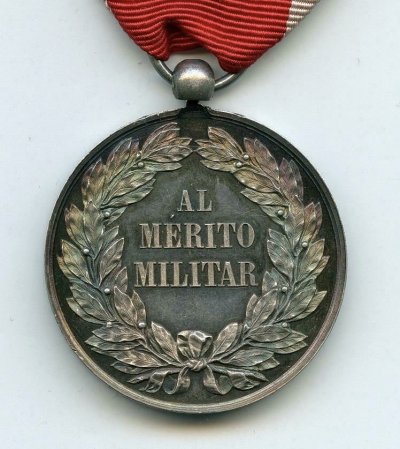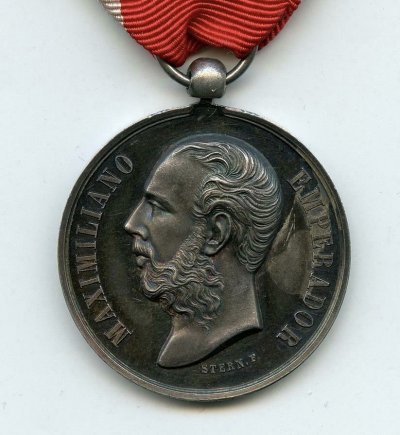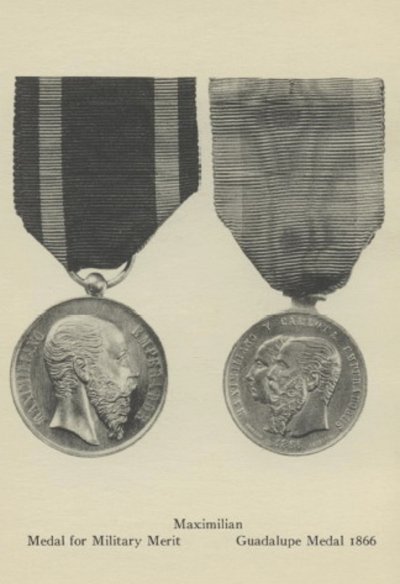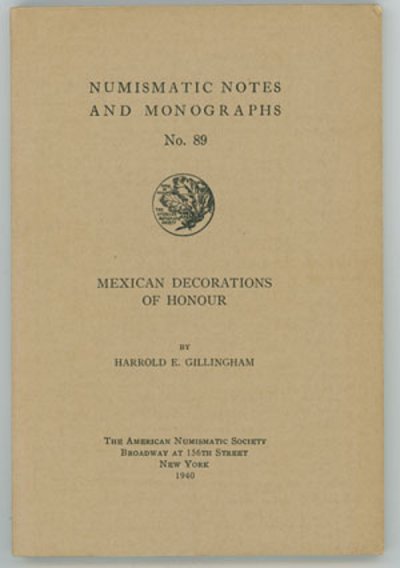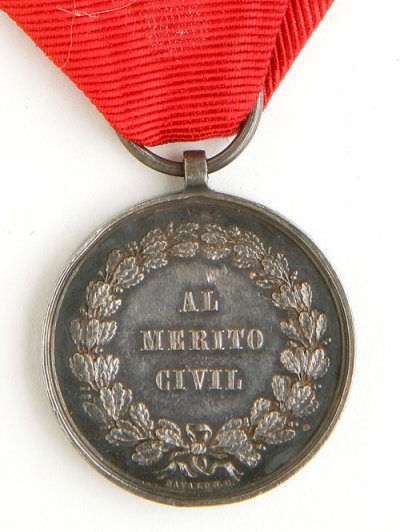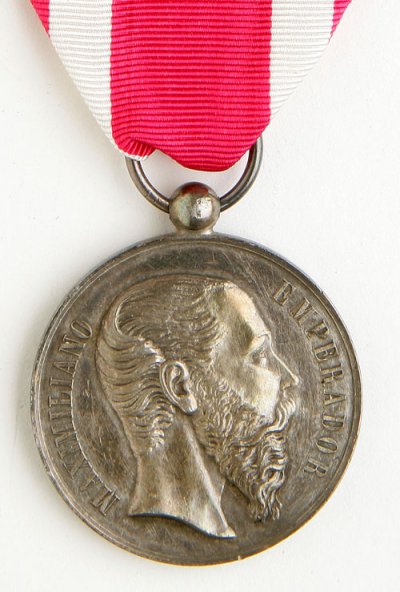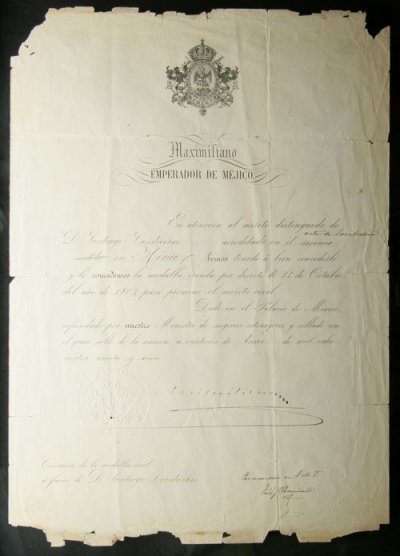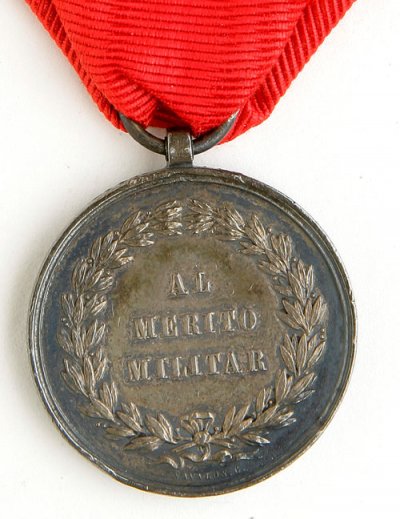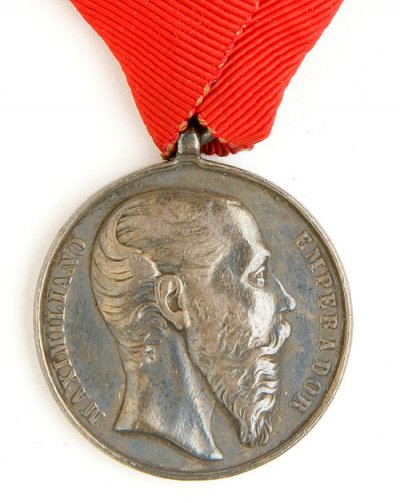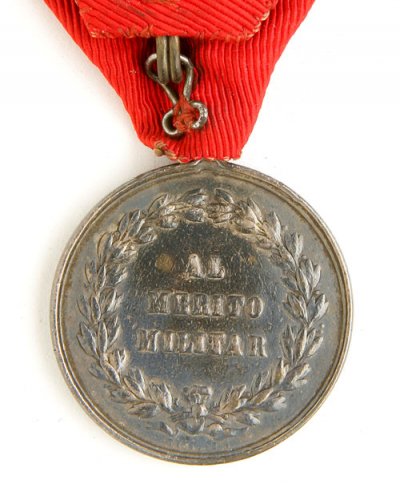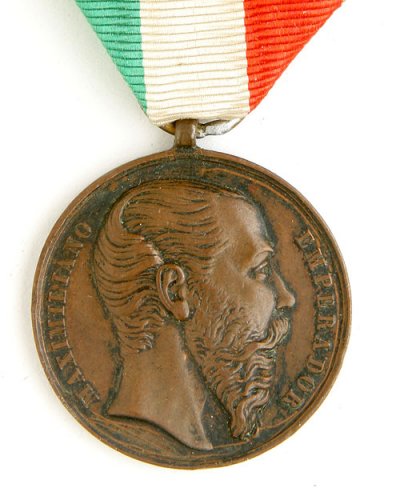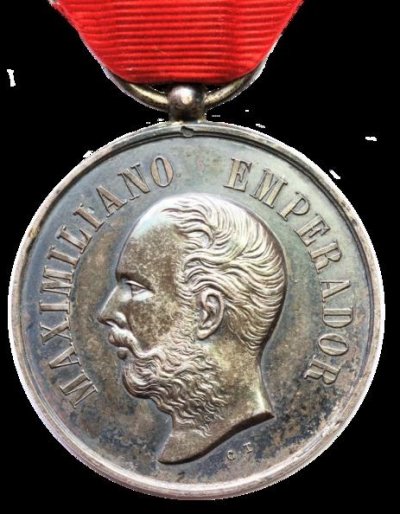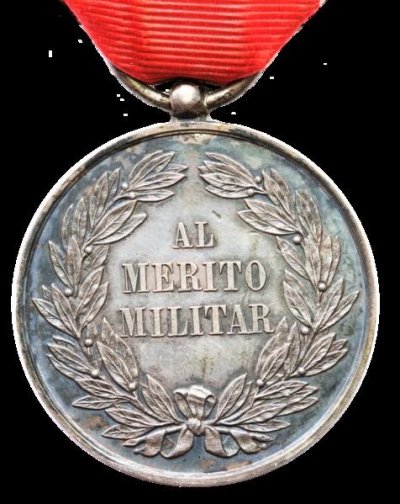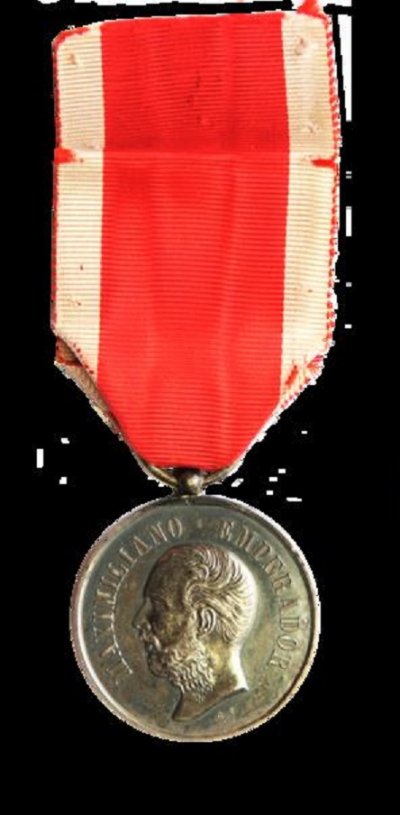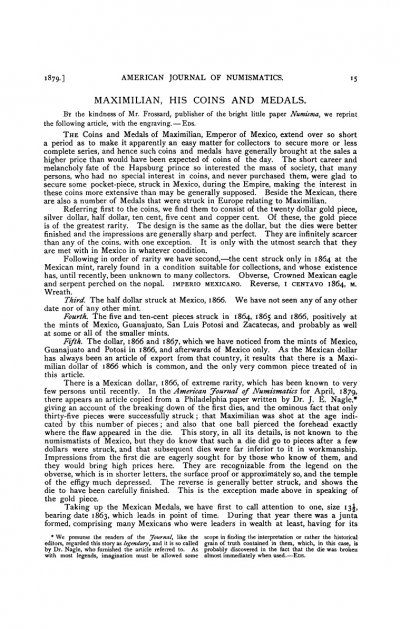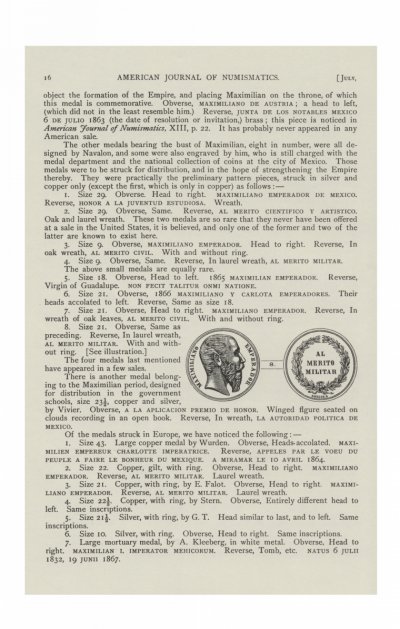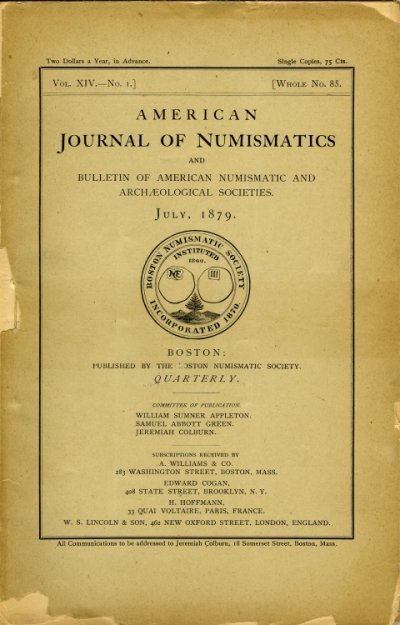Вы используете устаревший браузер. Этот и другие сайты могут отображаться в нём некорректно.
Вам необходимо обновить браузер или попробовать использовать другой.
Вам необходимо обновить браузер или попробовать использовать другой.
Мексика - Медаль за военные/гражданские заслуги/Al Mérito Militar/Civil
- Автор темы Igor Ostapenko
- Дата начала
Михаил Беленький
Модератор
На неё цена была какая-то нереальная. 

MAXIMILIAN'S DECORATION FOR MERIT.
Created October 14, 1863, for civil and military merit. Some authorities give the date as March 10, 1865. There were three classes, the first a gold cross, the second a silver medal and the third a bronze medal. The cross is of white enamel and, if awarded for military merit, is surmounted by trophies of arms. On the obverse is IMPERIO MEXICANO 1863. On the reverse is the Mexican eagle and the words AL MERITO CIVIL or AL MERITO MILITAR, according to the award. The second and third class medals have on the obverse the head of the Emperor facing to the right and the legend MAXIMILIANO EMPERADOR. The reverse shows the inscription AL MERITO CIVIL or AL MERITO MILITAR, according to the award, within a laurel wreath. General Falls, in his notes on medal ribbons, shows the first class as bright red, watered, 37 mm. wide; the second class as bright red moiré (38 mm.) with white side stripes (5 mm.) placed 4 mm. from the edges. The third class watered ribbon (37 mm.) is composed of three equal stripes, green, red and white. A second class medal for military merit in the American Numismatic Society collection has a red ribbon 30 mm. wide with white side stripes 5.5 mm., 3 mm. from the edges. These medals are found in various sizes, 33, 34, 37, or 39 mm. in diameter. Some were designed by S. C. Navalon, others by E. Falot, while those by Charles Trotin and René Stern show the Emperor's head facing to the left. Variations in the lettering may also be noticed. Wahlen illustrates a gold medal for military merit and states that the medal for civil merit is suspended from a green ribbon.
Created October 14, 1863, for civil and military merit. Some authorities give the date as March 10, 1865. There were three classes, the first a gold cross, the second a silver medal and the third a bronze medal. The cross is of white enamel and, if awarded for military merit, is surmounted by trophies of arms. On the obverse is IMPERIO MEXICANO 1863. On the reverse is the Mexican eagle and the words AL MERITO CIVIL or AL MERITO MILITAR, according to the award. The second and third class medals have on the obverse the head of the Emperor facing to the right and the legend MAXIMILIANO EMPERADOR. The reverse shows the inscription AL MERITO CIVIL or AL MERITO MILITAR, according to the award, within a laurel wreath. General Falls, in his notes on medal ribbons, shows the first class as bright red, watered, 37 mm. wide; the second class as bright red moiré (38 mm.) with white side stripes (5 mm.) placed 4 mm. from the edges. The third class watered ribbon (37 mm.) is composed of three equal stripes, green, red and white. A second class medal for military merit in the American Numismatic Society collection has a red ribbon 30 mm. wide with white side stripes 5.5 mm., 3 mm. from the edges. These medals are found in various sizes, 33, 34, 37, or 39 mm. in diameter. Some were designed by S. C. Navalon, others by E. Falot, while those by Charles Trotin and René Stern show the Emperor's head facing to the left. Variations in the lettering may also be noticed. Wahlen illustrates a gold medal for military merit and states that the medal for civil merit is suspended from a green ribbon.
"Австро-венгерская перспектива" на эту медаль http://www.austro-hungarian-army.co.uk/mexican/mxmedals.htm
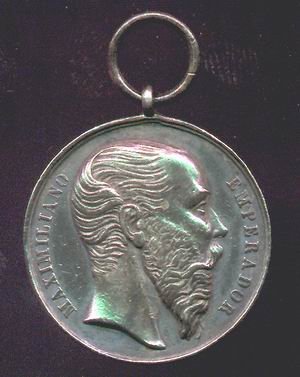
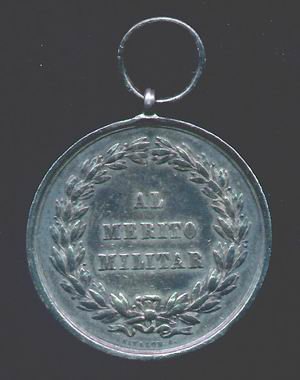
Instituted in 1865 to honour all kinds of military merit and acts of bravery in the field in three classes - Bronze, Silver and Gold. The round medals, 32 mm in diameter, were to be worn on a plain red ribbon. The obverse shows the head of Kaiser Maximilian, looking to the right with the surrounding inscription "MAXIMILIANO EMPERADOR". The reverse shows in three lines the inscription "AL/MERITO/MILITAR" surrounded by two laurel-twigs bound on the bottom by a bow, at the bottom is the name of the artist "NAVALON.G.". At the Münzkabinett of the Viennese Kunsthistorisches Museum where the orders, medals etc. of Maximilian are stored they give the weights of the golden medal at 26,7 grams and for the silver medal at 16,9 grams in their catalogues.
The Gold and Silver Medals were awarded, similar to the Austrian Bravery Medals, only for bravery during battle to non commissioned personnel, while the Bronze Medal was awarded, similar to the 1890 introduced Signum Laudis, as a sign that someone had received the commendation of the Kaiser. Consequently the Bronze medal could be awarded to officers as well as to common soldiers. Several veterans, who published their memoirs, reported that these medals were never awarded to members of the French Army as some kind of unwritten rule. During the siege of Querétaro, on the 30th March 1867, Kaiser Maximilian was honored by his loyal troops with the award of the Bronze Military Merit Medal. On his last photo, taken on the 2nd of May, where he is wearing a sombrero on his head and a navy telescope under his left arm he is also proudly wearing this decoration. On his last letter in June 1867 to his mother he was devoting this medal to her as his last souvenir.
The Civil Merit Medal - Condecoracion al Merito Civil
Instituted in 1865 to honour all kinds of civilian merit in three classes - Bronze, Silver and Gold. The round medals, 32 mm in diameter, were to be worn on a plain red ribbon and were similar to the Military Merit Medal, only on the reverse the inscription is "AL/MERITO/CIVIL" surrounded by oak-twigs instead of laurel-twigs. The Münzkabinett gives the weight of their golden medal at 24,4 grams and for the silver medal at 14,75 grams in their catalogues. The Civil Merit Medal was to cover the same range as the Austrian Merit Crosses with and without crown and is surely much rarer than the military medal.
The Merit Medal for Science and Fine Arts - Condecoracion al Merito Cientifico y Artistico
Kaiser Maximilian was a great patron of any kind of science and collector of historical artifacts and fine arts. On the 10th of April 1865 Emperor Maximilian founded the Mexican Academy of Science (Academia Imperial de Ciencia y Literatura) to promote any kind of scientific work. As their first president José Fernando Ramírez were inaugurated on the 6th of July 1865. Also in 1865 he founded the Mexican National Museum and sent Simon Leo Reinisch to Egypt to buy items for a projected Egyptian display. The plan for such a Museo Nacional was devoted to the historian and geographer M. Orozco y Berra (1816-1881), a state-secretary at the ministry for public work, who became first director of this museum on the 19th of January 1867.
To honor all kind of merit in the area of scientific work and fine arts Emperor Maximilian introduced a round, 45 mm diameter, cased medal (not to be worn on a ribbon) in three classes - Bronze, Silver and Gold. The obverse showed the head of Maximilian, looking to the right, with the surrounding inscription "MAXIMILIANO EMPERADOR DE MEXICO" and on the bottom the small signs of the artists G. Navalon and D. Ocampo. On the reverse is to be found the inscription in five lines "AL/MERITO/CIENTIFICO/Y/ARTISTICO" surrounded by a laurel and an oak twig bound on the bottom by a bow. The Münzkabinett gave the weight of their medals in gold at 54,7 grams and in silver at 39 grams in their catalogues. It was said that these medals would only be awarded to Mexicans, this could not be confirmed, but it is a fact that leading European artists and scientists were honored with the award of orders (mainly the Order of our beloved Madonna of Guadalupe) and not with this medal!
The Medal for excellent effort at School - Premio a la Juventud Estudiosa
At the end of the 18th and the begin of the 19th century so-call "Schulpreis-" or "Schulprämienmedaille" were awarded by the Austrian Kaiser to honor excellent efforts of pupils and students. Very little is known or published about these medals and less than this about the Mexican equivalents. It seems that in late 1865 Emperor Maximilian introduced, or probably only planned the institution, of such medals in three classes - Bronze, Silver and Gold. The Münzkabinett at Vienna only own a Gold and a Silver issue of this medal of 67,4 grams and 38,3 grams weight respectively. The obverse of these 45 mm in diameter medals is similar to the Merit Medal for Science and Fine Arts, possibly the same die. On the reverse two laurel twigs, bound on the bottom by a bow, surrounded a plain field, obviously for engraving a name and/or a date. These laurel-twigs were surrounded by the inscription "HONOR A LA JUVENTUD ESTUDIOSA".


The Military Merit Medal - Condecoracion al Merito Militar
Instituted in 1865 to honour all kinds of military merit and acts of bravery in the field in three classes - Bronze, Silver and Gold. The round medals, 32 mm in diameter, were to be worn on a plain red ribbon. The obverse shows the head of Kaiser Maximilian, looking to the right with the surrounding inscription "MAXIMILIANO EMPERADOR". The reverse shows in three lines the inscription "AL/MERITO/MILITAR" surrounded by two laurel-twigs bound on the bottom by a bow, at the bottom is the name of the artist "NAVALON.G.". At the Münzkabinett of the Viennese Kunsthistorisches Museum where the orders, medals etc. of Maximilian are stored they give the weights of the golden medal at 26,7 grams and for the silver medal at 16,9 grams in their catalogues.
The Gold and Silver Medals were awarded, similar to the Austrian Bravery Medals, only for bravery during battle to non commissioned personnel, while the Bronze Medal was awarded, similar to the 1890 introduced Signum Laudis, as a sign that someone had received the commendation of the Kaiser. Consequently the Bronze medal could be awarded to officers as well as to common soldiers. Several veterans, who published their memoirs, reported that these medals were never awarded to members of the French Army as some kind of unwritten rule. During the siege of Querétaro, on the 30th March 1867, Kaiser Maximilian was honored by his loyal troops with the award of the Bronze Military Merit Medal. On his last photo, taken on the 2nd of May, where he is wearing a sombrero on his head and a navy telescope under his left arm he is also proudly wearing this decoration. On his last letter in June 1867 to his mother he was devoting this medal to her as his last souvenir.
The Civil Merit Medal - Condecoracion al Merito Civil
Instituted in 1865 to honour all kinds of civilian merit in three classes - Bronze, Silver and Gold. The round medals, 32 mm in diameter, were to be worn on a plain red ribbon and were similar to the Military Merit Medal, only on the reverse the inscription is "AL/MERITO/CIVIL" surrounded by oak-twigs instead of laurel-twigs. The Münzkabinett gives the weight of their golden medal at 24,4 grams and for the silver medal at 14,75 grams in their catalogues. The Civil Merit Medal was to cover the same range as the Austrian Merit Crosses with and without crown and is surely much rarer than the military medal.
The Merit Medal for Science and Fine Arts - Condecoracion al Merito Cientifico y Artistico
Kaiser Maximilian was a great patron of any kind of science and collector of historical artifacts and fine arts. On the 10th of April 1865 Emperor Maximilian founded the Mexican Academy of Science (Academia Imperial de Ciencia y Literatura) to promote any kind of scientific work. As their first president José Fernando Ramírez were inaugurated on the 6th of July 1865. Also in 1865 he founded the Mexican National Museum and sent Simon Leo Reinisch to Egypt to buy items for a projected Egyptian display. The plan for such a Museo Nacional was devoted to the historian and geographer M. Orozco y Berra (1816-1881), a state-secretary at the ministry for public work, who became first director of this museum on the 19th of January 1867.
To honor all kind of merit in the area of scientific work and fine arts Emperor Maximilian introduced a round, 45 mm diameter, cased medal (not to be worn on a ribbon) in three classes - Bronze, Silver and Gold. The obverse showed the head of Maximilian, looking to the right, with the surrounding inscription "MAXIMILIANO EMPERADOR DE MEXICO" and on the bottom the small signs of the artists G. Navalon and D. Ocampo. On the reverse is to be found the inscription in five lines "AL/MERITO/CIENTIFICO/Y/ARTISTICO" surrounded by a laurel and an oak twig bound on the bottom by a bow. The Münzkabinett gave the weight of their medals in gold at 54,7 grams and in silver at 39 grams in their catalogues. It was said that these medals would only be awarded to Mexicans, this could not be confirmed, but it is a fact that leading European artists and scientists were honored with the award of orders (mainly the Order of our beloved Madonna of Guadalupe) and not with this medal!
The Medal for excellent effort at School - Premio a la Juventud Estudiosa
At the end of the 18th and the begin of the 19th century so-call "Schulpreis-" or "Schulprämienmedaille" were awarded by the Austrian Kaiser to honor excellent efforts of pupils and students. Very little is known or published about these medals and less than this about the Mexican equivalents. It seems that in late 1865 Emperor Maximilian introduced, or probably only planned the institution, of such medals in three classes - Bronze, Silver and Gold. The Münzkabinett at Vienna only own a Gold and a Silver issue of this medal of 67,4 grams and 38,3 grams weight respectively. The obverse of these 45 mm in diameter medals is similar to the Merit Medal for Science and Fine Arts, possibly the same die. On the reverse two laurel twigs, bound on the bottom by a bow, surrounded a plain field, obviously for engraving a name and/or a date. These laurel-twigs were surrounded by the inscription "HONOR A LA JUVENTUD ESTUDIOSA".
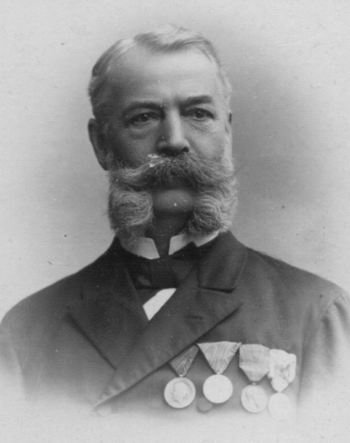
Adolf Jeanot, born in 1840 at Kremsier, volunteered as a Jäger on the 15th September 1864 for the Corps. On the 8th of October 1865 he was promoted to Patrulführer (Gefreiter) followed by the award of the bronze Military Merit Medal on the 8th December of the same year. On the 6th July 1866 he was promoted to Führer (Zugsführer) and finally to Oberjäger (Feldwebel) on the 1st of October 1866. After his return to Austria he joined the private railway company of the Nordwest-Bahn were he received the rank of Oberrevident before his retirement in 1905.
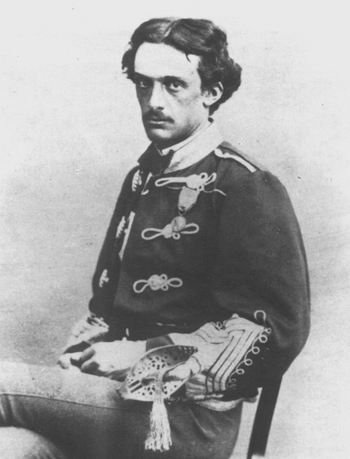
Karl Graf Khevenhüller-Metsch, Colonel and commander of the famous Red Hussars of the Mexican National Army, wearing the bronze Military Merit Medal.
As mentioned above, the bronze Military Merit Medal was a visible sign that someone had received the commendation of the Emperor and so, in contrast to the medals in silver or gold, it could be won by all ranks from the common soldier up to the highest general ranks.

 , из сети
, из сети